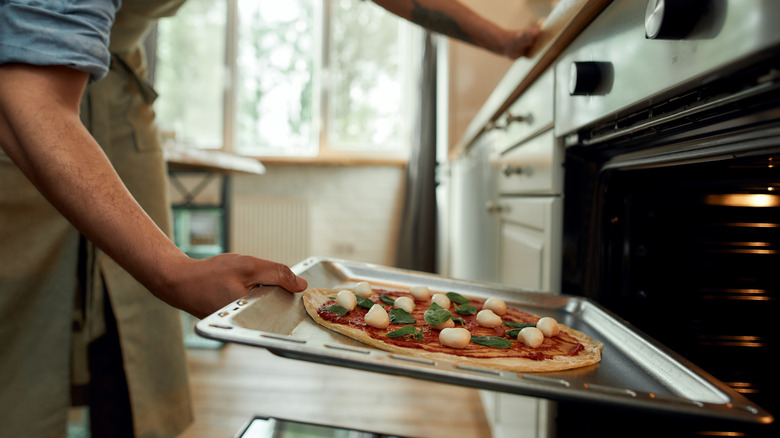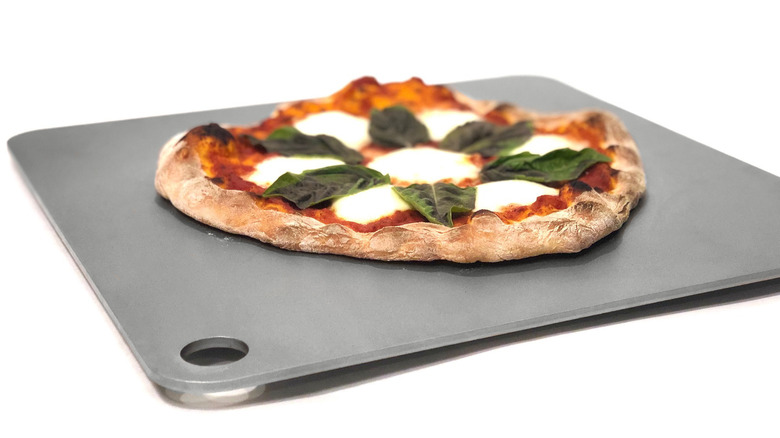The Best Way To Prevent Homemade Pizza From Getting Soggy
One of the best things about New York City is the pizza. The architecture is stunning, the energy is teeming, and the culture is endlessly inspiring. But we have to talk about the pizza.
In his now-famous 1980 interview with David Sheff for Playboy magazine, when asked about his diet, John Lennon replied, "We're mostly macrobiotic, but sometimes I take the family out for pizza." And we get it. In 1980, Lennon was living at The Dakota, an apartment building in Central Park West. He was mere steps away from some of the best pizza Manhattan had to offer.
But, admittedly, we don't all share such a short commute to the crème de la crème of 'za. For the rest of us, we can create that perfect New York slice in the oven at home — or can we? There always seems to be one common hangup for newbie at-home pizza chefs: soggy crust.
Taking the time to make a pizza from scratch and ending up with a doughy center is a drag, at best. Or worse, nobody likes popping their soggy dough back in the oven, only to find that the crust's too hard now.
Luckily, the pizza experts have a solution, and it's simple enough for even the newest pizza novices.
Add bottom heat
The culprit behind your soggy pizza crust might be imbalanced heat. The professionals at Crust Kingdom define that doughy midsection in the crust as the "gum line." In the pizza industry, this is the area between the tomato sauce and the bottom of the pizza that often remains uncooked. The goal, they say, is to get the gum line as thin as possible.
How to do it? Artisanal pizza masters at Neo Pizza explain that a thick gum line usually comes from an excess amount of heat coming from the top of the oven and proportionately less heat coming from the bottom.
Unfortunately, a number of factors can influence top and bottom temperature. Ovens are often to blame; Neo recommends baking the pizza on the bottom rack to offset the imbalance from the oven's heating element. For a thorough, even bake, Doh Wah recommends setting at-home ovens to 475 degrees Fahrenheit. They suggest a cook time of 10-12 minutes for a pie with a 14-to-16-inch diameter.
Pizza steel
There's another sneaky contributor to soggy crust: your ol' reliable baking sheet.
When you place your dough on a baking sheet, Neo Pizza says, the coolness of the sheet transfers a colder temperature to the bottom of the pizza crust. The Pizza Heaven adds that baking sheets can also trap moisture under the pizza, which makes the top cook quicker than the bottom.
Instead of a baking sheet — or even a pizza stone — modern pizza makers are opting for pizza steel. So, what sets pizza steel apart? A pizza steel is a quarter-inch-thick piece of metal that heats up faster than a traditional pizza stone, via The Pizza Heaven. They also report that the pizza steel is virtually indestructible and easier to clean than a pizza stone, which makes its higher price point worth it.
Crust Kingdom sings the praises of the new pizza steel technology, too, reporting that it conducts heat faster and more evenly. According to Neo Pizza, for best results, place your pizza steel in the oven while it preheats. That way, when it's time to bake, the pizza steel will already be warmed up and won't shock your dough with a colder temperature. Your crust will also take less time to cook this way.
Other sneaky factors
Even without the pizza steel or stone, there are other ways to curb soggy crust at home. Be sure to limit your wet toppings. If you're using fresh mozzarella, drain off the excess moisture, and then press the mozzarella between paper towels like tofu.
Thin tomato sauce is another culprit. Doh Wah recommends using whole peeled tomatoes for your sauce instead of canned tomatoes, which are packed with added moisture. Crust Kingdom suggests that, if you're loading up your pizza with veggie toppings, saute them on the stovetop for a few minutes to cook off some of their natural water content.
Pizza craftsmanship can seem closer to pottery than cooking, at times. Stretching the base thin and even is a matter of practice, and it takes time to get right. When it doesn't bake just right, don't get discouraged and turn to frozen pizza. With these tips, your home oven will be cranking out New York-style pies in no time.



